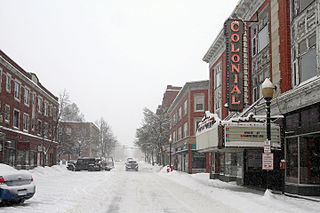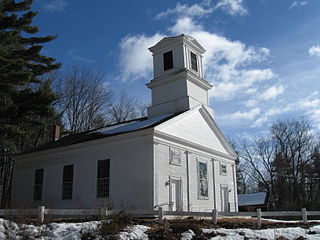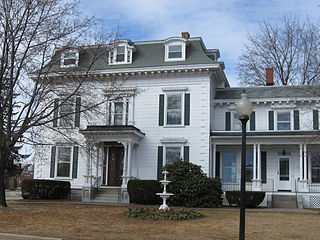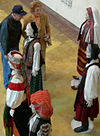
Belknap County is a county in the U.S. state of New Hampshire. As of the 2020 census, the population was 63,705. The county seat is Laconia. It is located in New Hampshire's Lakes Region, slightly southeast of the state's geographic center. Belknap County comprises the Laconia, NH Micropolitan Statistical Area, which in turn constitutes a portion of the Boston-Worcester-Providence, MA-RI-NH-CT Combined Statistical Area.

Belmont is a town in Belknap County, New Hampshire, United States. The population was 7,314 at the 2020 census.

Laconia is a city in Belknap County, New Hampshire, United States. The population was 16,871 at the 2020 census, up from 15,951 at the 2010 census. It is the county seat of Belknap County. Laconia, situated between Lake Winnipesaukee and Lake Winnisquam, includes the villages of Lakeport and Weirs Beach. Each June, for nine days, beginning on the Saturday of the weekend before Father's Day and ending on Father's Day, the city hosts Laconia Motorcycle Week, also more simply known as "Bike Week", one of the country's largest rallies, and each winter, the Laconia World Championship Sled Dog Derby. The city has been the site of the state's annual Pumpkin Festival since 2015, and it is the home of Lakes Region Community College.

Meredith is a town in Belknap County, New Hampshire, United States. The population was 6,662 at the 2020 census. Meredith is situated in the state's Lakes Region and serves as a major resort town. Meredith Village, the commercial center of the town, lies long the shores of Lake Winnipesaukee, and several other large lakes lie partially or completely within the town borders. It is home to the Stonedam Island Natural Area and the Winnipesaukee Scenic Railroad, and it serves as one of the ports of call for the paddle steamer MS Mount Washington.

The Evangelical Baptist Church is a historic church building on Veterans Square in Laconia, New Hampshire, United States. Built in 1836 and extensively restyled in 1871, it is a fine 19th-century building, illustrating adaptive alterations made over time to reflect changing uses and tastes. The building was listed on the National Register of Historic Places in 1985.

The First Baptist Church of Gilmanton, also known as the Lower Gilmanton Church, is a historic church building on Province Road, slightly north of Stage Road, in Gilmanton, New Hampshire. Built in 1842, the church is one of Belknap County's finest Greek Revival churches, and is accompanied by the county's most intact 19th-century horsesheds. The property was listed on the National Register of Historic Places in 1989.

The First Free Will Baptist Church in Meredith is a historic church building at 61 Winona Road in Meredith, New Hampshire, United States. Built about 1802 and remodeled in 1848, it is a good example of a mid-19th century vernacular Greek Revival rural church. It is now a museum called the Pottle Meeting House, managed by the local historical society. The building was listed on the National Register of Historic Places in 1986.

The Laconia Passenger Station is a historic railroad station at 9-23 Veterans Square in downtown Laconia, New Hampshire. It was built in 1892 for the Boston and Maine (B&M) Railroad and is a prominent regional example of Richardsonian Romanesque style architecture. It was added to the National Register of Historic Places in 1982. The building now houses a variety of commercial businesses.

The Holman & Merriman Machine Shop, also known as the Derby Shop, Goodnow Pail Factory, L. A. Carpenter Machine Shop, and Streeter Shop, is an historic industrial building at 63 Canal Street in Hinsdale, New Hampshire. This three-story brick building, built in 1837, is the only building with a clerestory roof in Hinsdale, and one of only four in the state. It is also distinctive as the only known example in the state of a building purpose-built as a large-scale cooperage. The building was listed on the National Register of Historic Places in December 2007, and the New Hampshire State Register of Historic Places in January 2007.

The Jaffrey Mills is a historic mill complex at 41 Main Street, in the central business district of Jaffrey, New Hampshire. It consists of a connected series of primarily brick buildings flanking the Contoocook River just north of Main Street. Its oldest buildings, the original mill and office building, are on the west side of the river. They were built in 1868, and feature mansard roofs and banded dentil brick cornices. The mill building has a tower that originally sported a cupola, but this was removed early in the 20th century. In 1872 the building on the east side was built, and the two sides joined by timber-frame bridges were added in 1897, at the same time the east building was extended northward. Later additions to the north of the east building include a storage area and a loading dock. The mill complex, the only 19th-century industrial complex of its type to be built in Jaffrey, was listed on the National Register of Historic Places in 1982. It has been converted into residences.

The Old Grafton County Courthouse is a historic courthouse building at 1 Court Street in Plymouth, New Hampshire. This modest wood frame building was built in 1774 to serve as one of two courthouses for Grafton County, which had just been established; it is one of the oldest surviving civic structures in the state. It is now the museum of the Plymouth Historical Society. The building was listed on the National Register of Historic Places in 1982, and included in the Plymouth Historic District in 1986.

The Hillsborough Mills are a historic textile manufacturing complex at 37 Wilton Road in western Milford, New Hampshire, near its town line with Wilton. The oldest buildings of the brick mill complex were built in 1866 as a carpet-making operation. This business failed in 1874, but the complex was acquired by other textile interests, and eventual saw success producing carpet yarns, and blankets for horses and bedding. The mills were closed in 1970, and have since been adapted for other uses. The complex was listed on the National Register of Historic Places in 2014.

The John W. Busiel House is a historic house at 30 Church Street in Laconia, New Hampshire. It was built in 1865 by John W. Busiel, owner of a local textile mill. It is now, as it was at the time of its construction, one of the finest 19th-century houses in the city, and is an excellent and little-altered example of Second Empire style. Since 1905 it has served as the rectory for the St. Joseph Roman Catholic church. The house was listed on the National Register of Historic Places in 1994.

The Busiel-Seeburg Mill is a historic mill building in Laconia, New Hampshire, since converted into an office building known as 1 Mill Plaza. This 3-1/2 story brick structure achieved its present configuration in stages, beginning in 1853, and successively altered and expanded through the rest of the 19th century. The business, established by John W. Busiel in 1846, manufactured knitted hosiery, and was one of the first producers of knitwear to use circular knitting machines invented by Aiken and Peppers. The building was listed on the National Register of Historic Places in 1971.

The former Federal Building in Laconia, New Hampshire, is located at 719 Main Street. It is a two-story brick Classical Revival structure designed by Louis A. Simon and built from 1939 to 1940. Originally built to house the offices of the White Mountain National Forest, it now houses a regional social services agency. The building was listed on the National Register of Historic Places in 2011.

The U.S. Post Office-Laconia Main is a historic post office building at 33 Church Street in Laconia, New Hampshire. Occupying a prominent corner site near the city's central business district, it was built in 1916-17 and is a prominent regional example of Beaux Arts architecture. The building was listed on the National Register of Historic Places in 1986.

The Laconia District Court is located at 26 Academy Street in Laconia, New Hampshire, in a Second Empire brick structure which was built by the city in 1886-87 to house its high school. It was designed by Frederick N. Footman of Boston, though preliminary designs had been obtained from Dow & Wheeler of Concord, New Hampshire. The building was listed on the National Register of Historic Places in 1982.

The Meredith Public Library is located at 91 Main Street in Meredith, New Hampshire. It is housed in a handsome brick Classical Revival structure designed by George Swan and built in 1900-01, with a major expansion in 1985. It was a gift from Benjamin Smith as a memorial to his parents, and is known as the Benjamin M. Smith Memorial Library. The building, one of the town's most architecturally sophisticated buildings, was listed on the National Register of Historic Places in 1984.

The Benjamin Rowe House is a historic house museum at 88 Belknap Mountain Road in Gilford, New Hampshire. Probably built in the 1830s, it is one of the town's best-preserved period houses. The house was listed on the National Register of Historic Places in 2008, and the New Hampshire State Register of Historic Places in 2003.

The Bridgewater Woolen Mill, now more commonly the Bridgewater Mill Mall, is a historic textile mill complex on United States Route 4 in Bridgewater and Woodstock, Vermont. With an textile processing history dating from 1828 to 1975, it was one of the state's longest-lived textile operations, and was a mainstay of the local economy during that period. It has since been repurposed into a shopping center. It was listed on the National Register of Historic Places in 1976.























